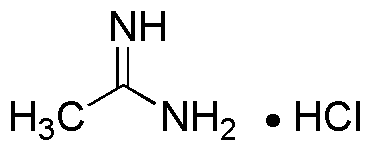Acetamidine hydrochloride is widely utilized in research focused on:
- Pharmaceutical Development: This compound serves as a building block in the synthesis of various pharmaceuticals, particularly in the development of analgesics and anti-inflammatory drugs.
- Agricultural Chemicals: It is used in formulating agrochemicals, enhancing crop protection products by acting as an intermediate in the synthesis of pesticides.
- Biochemical Research: Researchers employ acetamidine hydrochloride in studies related to enzyme inhibition and protein interactions, aiding in the understanding of biochemical pathways.
- Analytical Chemistry: This compound is utilized as a reagent in analytical methods, including chromatography, to improve the detection and quantification of various substances.
- Material Science: It finds applications in the development of polymers and other materials, contributing to innovations in coatings and adhesives.
General Information
Properties
Safety and Regulations
Applications
Acetamidine hydrochloride is widely utilized in research focused on:
- Pharmaceutical Development: This compound serves as a building block in the synthesis of various pharmaceuticals, particularly in the development of analgesics and anti-inflammatory drugs.
- Agricultural Chemicals: It is used in formulating agrochemicals, enhancing crop protection products by acting as an intermediate in the synthesis of pesticides.
- Biochemical Research: Researchers employ acetamidine hydrochloride in studies related to enzyme inhibition and protein interactions, aiding in the understanding of biochemical pathways.
- Analytical Chemistry: This compound is utilized as a reagent in analytical methods, including chromatography, to improve the detection and quantification of various substances.
- Material Science: It finds applications in the development of polymers and other materials, contributing to innovations in coatings and adhesives.
Documents
Safety Data Sheets (SDS)
The SDS provides comprehensive safety information on handling, storage, and disposal of the product.
Product Specification (PS)
The PS provides a comprehensive breakdown of the product’s properties, including chemical composition, physical state, purity, and storage requirements. It also details acceptable quality ranges and the product's intended applications.
Certificates of Analysis (COA)
Search for Certificates of Analysis (COA) by entering the products Lot Number. Lot and Batch Numbers can be found on a product’s label following the words ‘Lot’ or ‘Batch’.
Número de catálogo
Número de lote/lote
Certificates Of Origin (COO)
This COO confirms the country where the product was manufactured, and also details the materials and components used in it and whether it is derived from natural, synthetic, or other specific sources. This certificate may be required for customs, trade, and regulatory compliance.
Número de catálogo
Número de lote/lote
Safety Data Sheets (SDS)
The SDS provides comprehensive safety information on handling, storage, and disposal of the product.
DownloadProduct Specification (PS)
The PS provides a comprehensive breakdown of the product’s properties, including chemical composition, physical state, purity, and storage requirements. It also details acceptable quality ranges and the product's intended applications.
DownloadCertificates of Analysis (COA)
Search for Certificates of Analysis (COA) by entering the products Lot Number. Lot and Batch Numbers can be found on a product’s label following the words ‘Lot’ or ‘Batch’.
Número de catálogo
Número de lote/lote
Certificates Of Origin (COO)
This COO confirms the country where the product was manufactured, and also details the materials and components used in it and whether it is derived from natural, synthetic, or other specific sources. This certificate may be required for customs, trade, and regulatory compliance.

